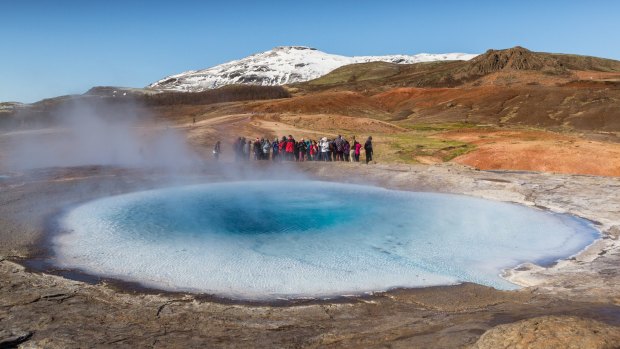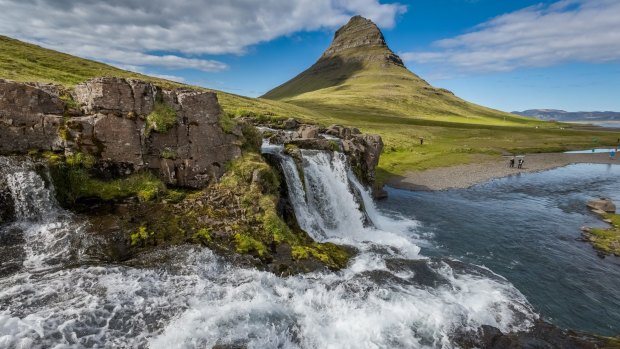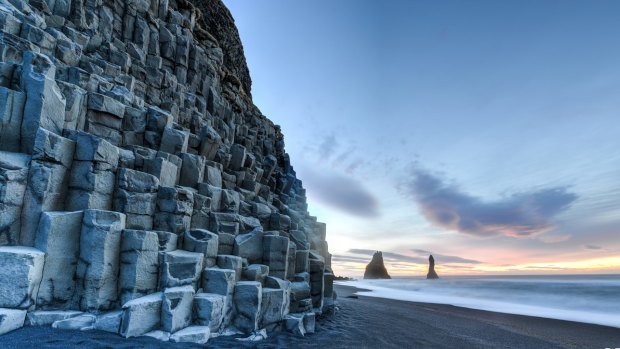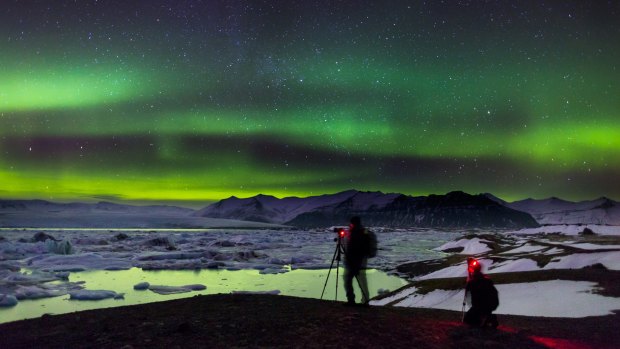This was published 6 years ago
Iceland's tourism boom: The country where travellers outnumber locals five to one
By Ute Junker

A natural thermal pool - Skolaferdalag
"There are three things you are guaranteed in Iceland," Magnus tells me, shortly after picking me up at the airport. "Good food, good coffee and bad hair days."
He's not wrong. As soon as we step outside the airport, wild gusts of wind send my hair shooting in all directions. For the rest of my stay in Iceland, my hair will be almost permanently out of control. It's just one of those things that happens in this part of the world. .
A lot of people have been experiencing bad hair days lately. This tiny country is in the middle of a tourism boom. The 2 million tourists that visited Iceland last year outnumbered the locals by more than five to one. It is not hard to understand what draws so many visitors. Iceland has a surfeit of natural wonders, from mighty glaciers and geysers to no fewer than 10,000 waterfalls, from the double-tiered Gullfoss to Seljalandsfoss, where a walking trail takes you behind the cascading water.

Kirkjufellsfoss waterfall.Credit: Ragnar Th Sigurdsson rth@arctic-images.com
It doesn't take me long to decide that Iceland's biggest attraction, however, is its people. Icelanders have a distinctively quirky world view. Perhaps that is what comes from living on an isolated island which is in darkness for half the year, a place where the average summer temperature is about 13 degrees. (In a clothing store window in Reykjavik, I see the following slogan stencilled on the window: "Waiting for summer since 1926.")
Icelanders, Magnus tells me, have learned to roll with the punches. "When the first settlers arrived here, around [the year] 871, 97 per cent of the island was covered with trees," he explains. That was before a 400-year ice age and 250 years of repeated volcanic eruptions changed the landscape into the bare, flat, treeless landscape of today. ("What do you do if you get lost in Icelandic forest?" Magnus asks me one day. When I can't come up with the answer, he supplies it. "You stand up.")
Iceland's early settlers came from a variety of countries, including Scandinavia and Ireland. Icelanders have developed a potted history of where they came from. "All the fun people left Norway, then stopped in at Copenhagen to pick up engineers and Britain for some pretty ladies," Magnus recounts with a straight face. "They left the sick people behind on the Faroe Islands, and then the rest came to Iceland."

The basalt sea stacks of Reynisdrangar in Iceland.
Icelanders may miss out on a lot of things – forests, big cities, summer – but they know how to count their blessings. All those volcanoes double as a useful power source – 97 per cent of homes are geothermally heated – and the water that flows from the tap comes straight from a glacier. What's more, Iceland grows its own apples, bananas and even kiwifruit, in greenhouses that draw on the same geothermal power.
One afternoon we stop in to have lunch in one of those greenhouses. Farmers Helena and Knutur Rafn Armann, who produce almost 400 tonnes of tomatoes annually, have set up a restaurant inside their greenhouse. The menu is limited and, not surprisingly, focused firmly on tomatoes, but their tomato soup is the best I have ever tasted.
Despite Icelanders' adaptability, the country is facing new challenges. Some of those are climatic. Since 2000, Icelanders have weathered a range of extraordinary weather events. Between 2000 and 2010, Magnus tells me, there was no snow at all. The winter of 2015/16, however, made up for it; in 70-odd days, they had 37 snowstorms.

The northern lights are one of the highlights of Iceland's winter.Credit: Ragnar Th. Sigurdsson / ARCTIC IMAGES
Then there is the tourist boom. While the money is, of course, welcome, particularly in a country that went bankrupt in 2008, the influx of visitors is bringing big changes.
Until now, sightseeing in Iceland has been a remarkably relaxed activity. Only a handful of the country's top attractions require you to buy a ticket; at the rest, you just show up. However, Iceland's parliament recently passed laws allowing for entry fees to be charged to national parks.
On the upside, entry fees will allow the country to supply badly needed new infrastructure, including public toilets. Iceland's closely knit community never had much need for public facilities, but the sheer number of visitors is changing that. As yet, only a few of the most popular attractions have public toilets, although the ones that do – such as Thingvellir, which is not only the place where two continental plates meet, but also the site where Iceland's first parliament met 1000 years ago – have been built to offer magnificent views.
The tourist onslaught has affected Iceland in other ways. Like the French, Icelanders have traditionally been very careful to preserve their language; with fewer than 400,000 native speakers, Icelandic needs all the help it can get. A permanent body, the Icelandic Language Committee, has the job of creating new Icelandic words by drawing on ancient vocabulary. The word for computer, for instance, tolva, is made by fusing the words tala (number) and volva (prophetess).
However, globalisation is taking its toll, exacerbated by the increasingly common sound of tourists speaking English on the streets. Linguists are warning that today's youth are less fluent in Icelandic than any previous generation.
Despite the challenges brought by the tourism boom, foreigners can still expect a warm welcome. I assume this is an intrinsic Icelandic trait, until an odd encounter on the last day of my trip. We are driving along the country's west coast when Magnus suddenly hits the brakes and reverses back to an intersection. He points at a sign indicating that the turn-off leads to a place called Junkaragedi.
"Isn't that like your name?" he asks.
It certainly is, which makes us wonder what the Junkers did to get an Icelandic place named after that. Magnus whips out his phone, and finds the explanation. The name refers to an ancient farm where a large number of foreigners, known as Junkers, lived. The men – strong men who drank a lot and were interested in the local women – got into conflict with the neighbours, who damaged the rowlocks of their boats. When the Junkers next went fishing, the rowlocks broke. The Junkers made it home by supporting the oars with their knees. The next time their oars were sawn half through and the saw marks were hidden. The Junkers went fishing and never came back.
The moral of the story: don't mess with Icelanders.
Ute Junker travelled with assistance from Abercrombie & Kent.
TRIP NOTES
MORE
FLY
Iceland Air offers direct flights to Reykjavik from 24 cities across Europe, including London, Paris, Berlin, Glasgow and Bergen. See icelandair.com
STAY
With sleek minimalist interiors and its own private thermally heated lagoon, Silica Hotel, just 10 minutes from the famous Blue Lagoon, is one of Iceland's most stylish places to stay. Rates from 52,400ISK. See bluelagoon.com
EAT
At Frioheimar, a restaurant inside a greenhouse an hour out of Reykjavik, the entire menu is based on tomatoes. See fridheimar.is/en/restaurant
TOUR
Abercrombie & Kent's seven-day private journey, Land of Fire & Ice, includes touring of the capital, the Golden Circle, Thorsmork, Landmannalaugar and the South Shore. Prices start from $10,595 a person twin share. Includes hotel accommodation, breakfast daily, four lunches, private transfers and transport, daily sightseeing and entrance fees. Phone 1300 590 317 or see abercrombiekent.com.au
Sign up for the Traveller Deals newsletter
Get exclusive travel deals delivered straight to your inbox. Sign up now.